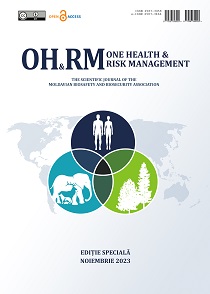Abstract
Introduction. In any clinical, veterinary, or research laboratory, special attention is crucial due to the nature of diagnostic samples and the uncertainty regarding the potential presence of any biological agent. This, in combination with handling and analysis procedures, poses a risk of possible laboratory infections (LAIs).
Aim. Therefore, it is imperative for all laboratories to identify and control these risks. This ensures the protection of laboratory professionals, patients, the community, and the environment from potential harm associated with samples and biological agents.
Material and methods. Ensuring the safe reception, processing, transportation, and storage of samples containing potential infectious biological agents involves elements of Biosafety and Biosecurity. The Laboratory Biorisk Management System, outlined in ISO 35001:2019, is designed to control and mitigate these risks. Risk Assessment is the core component of the Laboratory Biorisk Management system, aiming to identify, mitigate, and manage laboratory risks to an acceptable level. Specific steps are taken to gather information, determine risks, and select appropriate control measures to mitigate these risks to an acceptable level.
Results. Controlling biological risks in the laboratory requires the following: identification of these risks through risk assessment and the implementation of the hierarchy of controls, which comprises a combination of engineering and administrative controls, good microbiological practices and procedures, and appropriate personal protective equipment. Key factors in managing biological risks and conducting risk assessments are professionals with expertise, specifically Biorisk Management Advisors (Biosafety Officers). These advisors play a crucial role in advising, informing, and guiding the implementation of Good Laboratory Practices, the development of training programs, and Biorisk Management Systems. Competent biosafety and biosecurity professionals serve as a foundational element in global health security, preparedness, and response to outbreaks of infectious diseases, as well as in the safe and secure handling of biological materials in laboratories and other organizations. Biorisk management advisors should possess education in the life sciences, critical thinking, and effective problem-solving skills that best meet local needs. The following core competencies, actively trained, are essential: Biorisk assessment and management, Containment principles, International and national regulatory framework, standards and guidelines, Infection control, biological waste management, Auditing and inspections, Human factors, and Bioethics.
Conclusions. Implementing a Biorisk Management system and appointing competent Biorisk Management Advisors is crucial for several reasons. It ensures the creation of safer laboratory facilities, the elimination or minimization of biological risks to acceptable levels, the improvement of the quality of diagnostic tests, and the re-evaluation of the current biosafety and biosecurity system towards a performance-based, holistic, risk-management system approach.
|
 Views: 102|
|
Views: 102|
|
This work is licensed under a Creative Commons Attribution 4.0 International License.

